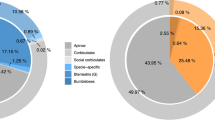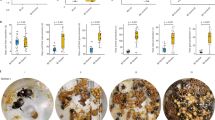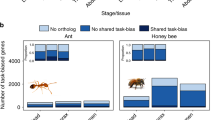Abstract
In honeybee societies, distinct caste phenotypes are created from the same genotype, suggesting a role for epigenetics in deriving these behaviorally different phenotypes. We found no differences in DNA methylation between irreversible worker and queen castes, but substantial differences between nurses and forager subcastes. Reverting foragers back to nurses reestablished methylation levels for a majority of genes and provides, to the best of our knowledge, the first evidence in any organism of reversible epigenetic changes associated with behavior.
This is a preview of subscription content, access via your institution
Access options
Subscribe to this journal
Receive 12 print issues and online access
$209.00 per year
only $17.42 per issue
Buy this article
- Purchase on Springer Link
- Instant access to full article PDF
Prices may be subject to local taxes which are calculated during checkout


Similar content being viewed by others
References
Ji, H. et al. Nature 467, 338–342 (2010).
Wolf, C. & Linden, D.E. Genes Brain Behav. 11, 3–28 (2012).
Wang, Y. et al. Science 314, 645–647 (2006).
Winston, M.L. The Biology of the Honey Bee (Harvard University Press, 1987).
Whitfield, C.W. Science 302, 296–299 (2003).
Robinson, G.E., Page, R.E., Strambi, C. & Strambi, A. Ethology 90, 336–348 (1992).
Elango, N., Hunt, B.G., Goodisman, M.A. & Yi, S.V. Proc. Natl. Acad. Sci. USA 106, 11206–11211 (2009).
Lyko, F. et al. PLoS Biol. 8, e1000506 (2010).
Suganuma, T. et al. Nat. Struct. Mol. Biol. 15, 364–372 (2008).
Tsukiyama, T., Daniel, C., Tamkun, J. & Wu, C. Cell 83, 1021–1026 (1995).
Barak, O. et al. EMBO J. 22, 6089–6100 (2003).
Terriente-Félix, A., Molnar, C., Gómez-Skarmeta, J.L. & de Celis, J.F. Dev. Biol. 350, 382–392 (2011).
Melicharek, D.J., Ramirez, L.C., Singh, S., Rhea, T. & Marenda, D.R. Hum. Mol. Genet. 19, 4253–4264 (2010).
Amdam, G.V. Aging Cell 10, 18–27 (2011).
Goldman-Levi, R., Miller, C., Bogoch, J. & Zak, N.B. Nucleic Acids Res. 24, 3121–3128 (1996).
Linder, P. Nucleic Acids Res. 34, 4168–4180 (2006).
Parsyan, A. et al. Nat. Rev. Mol. Cell Biol. 12, 235–245 (2011).
Guo, J.U. et al. Nat. Neurosci. 14, 1345–1351 (2011).
Miller, C.A. & Sweatt, J.D. Neuron 53, 857–869 (2007).
Weaver, I.C. et al. Nat. Neurosci. 7, 847–854 (2004).
Amdam, G.V. et al. Exp. Gerontol. 40, 939–947 (2005).
Page, R.E. & Fondrk, M.K. Behav. Ecol. Sociobiol. 36, 135–144 (1995).
Laidlaw, H.H. & Page, R.E. Queen Rearing and Bee Breeding (Wicwas Press, 1997).
Aryee, M.J. et al. Biostatistics 12, 197–210 (2011).
Irizarry, R.A. et al. Genome Res. 18, 780–790 (2008).
Huang, D.W., Sherman, B.T. & Lempicki, R.A. Nat. Protoc. 4, 44–57 (2009).
Hansen, K.D. et al. Nat. Genet. 43, 768–775 (2011).
Lister, R. et al. Nature 462, 315–322 (2009).
Langmead, B. & Salzberg, S.L. Nat. Methods 9, 357–359 (2012).
Trapnell, C., Pachter, L. & Salzberg, S.L. Bioinformatics 25, 1105–1111 (2009).
Acknowledgements
We thank E. Fennern, N. Baker, K. Flores and O. Kaftanoglu for assistance with colonies, bees and brain dissections, and A. Doi for reviewing the manuscript. We thank G. Klein for serving as scientific schadchen to A.P.F. and G.V.A. after hearing them lecture on different occasions at I. Ernberg's “What is Life” series at the Karolinska Institute, without which this research would not have taken place. G.V.A. was funded by the Research Council of Norway #191699 and the PEW Charitable Trust #2009-000068-001. A.P.F. was funded by US National Institutes of Health grant 1DP1OD008324.
Author information
Authors and Affiliations
Contributions
B.R.H. performed genome-scale, gene-specific DNA methylation analysis and performed gene expression analysis. F.W. raised bees and manipulated hives for reversion experiment, and collected bees and dissected brains. R.I., M.J.A., K.D.H., B.L. and B.R.H. performed statistical analysis. B.R.H. and M.J.A. generated microarray data sets. B.R.H., B.L. and K.D.H. generated WGBS and RNAseq data sets. A.P.F. and G.V.A. conceived, designed and oversaw the experiments. A.P.F., B.R.H. and G.V.A. wrote the paper with the assistance of K.D.H., M.J.A., B.L. and F.W.
Corresponding authors
Ethics declarations
Competing interests
The authors declare no competing financial interests.
Supplementary information
Supplementary Text and Figures
Supplementary Figures 1–9 (PDF 8163 kb)
Supplementary Tables
Supplementary Tables 1–10 (XLS 148 kb)
Rights and permissions
About this article
Cite this article
Herb, B., Wolschin, F., Hansen, K. et al. Reversible switching between epigenetic states in honeybee behavioral subcastes. Nat Neurosci 15, 1371–1373 (2012). https://doi.org/10.1038/nn.3218
Received:
Accepted:
Published:
Issue Date:
DOI: https://doi.org/10.1038/nn.3218
This article is cited by
-
Family before work: task reversion in workers of the red imported fire ant, Solenopsis invicta in the presence of brood
Scientific Reports (2023)
-
DNMT1 mutant ants develop normally but have disrupted oogenesis
Nature Communications (2023)
-
Developmental and Injury-induced Changes in DNA Methylation in Regenerative versus Non-regenerative Regions of the Vertebrate Central Nervous System
BMC Genomics (2022)
-
Individual experience influences reconstruction of division of labour under colony disturbance in a queenless ant species
Frontiers in Zoology (2022)
-
Changes in gene body methylation do not correlate with changes in gene expression in Anthozoa or Hexapoda
BMC Genomics (2022)



